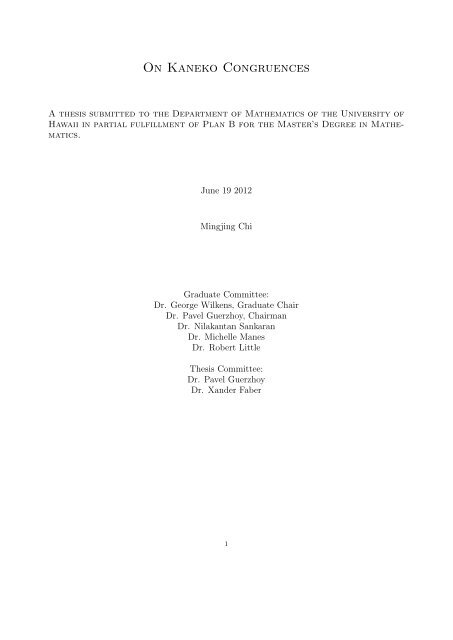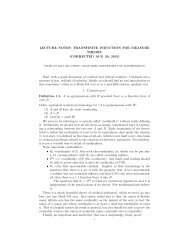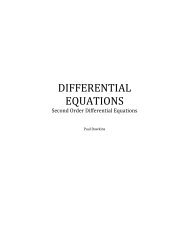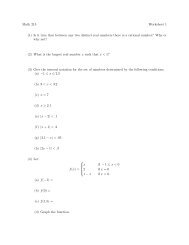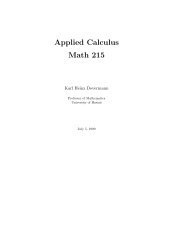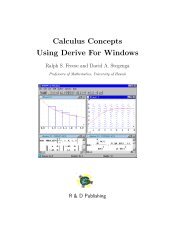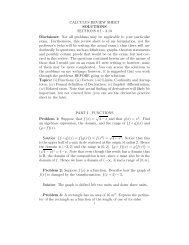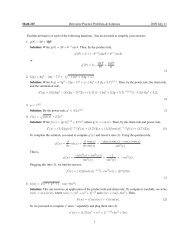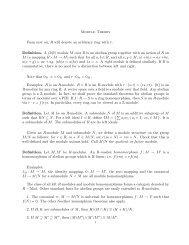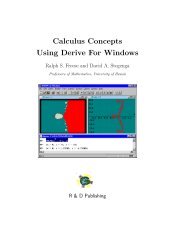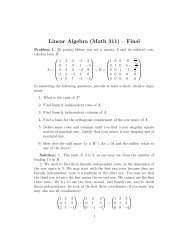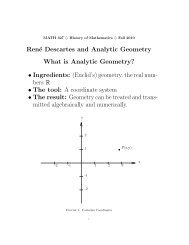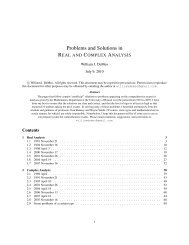MA thesis available - University of Hawaii
MA thesis available - University of Hawaii
MA thesis available - University of Hawaii
Create successful ePaper yourself
Turn your PDF publications into a flip-book with our unique Google optimized e-Paper software.
On Kaneko Congruences<br />
A <strong>thesis</strong> submitted to the Department <strong>of</strong> Mathematics <strong>of</strong> the <strong>University</strong> <strong>of</strong><br />
<strong>Hawaii</strong> in partial fulfillment <strong>of</strong> Plan B for the Master’s Degree in Mathematics.<br />
June 19 2012<br />
Mingjing Chi<br />
Graduate Committee:<br />
Dr. George Wilkens, Graduate Chair<br />
Dr. Pavel Guerzhoy, Chairman<br />
Dr. Nilakantan Sankaran<br />
Dr. Michelle Manes<br />
Dr. Robert Little<br />
Thesis Committee:<br />
Dr. Pavel Guerzhoy<br />
Dr. Xander Faber<br />
1
2<br />
Acknowledgments<br />
I would like to express the deepest appreciation to my advisor, Pr<strong>of</strong>essor Pavel Guerzhoy.<br />
You have been incredibly patient through the years to a student whose head is too <strong>of</strong>ten<br />
in the clouds. Without your guidance and persistent help, this project would remain in my<br />
dream.<br />
My gratitude also goes to Pr<strong>of</strong>essor J.B. Nation. You have enriched my time here at the<br />
Mathmatics Department in a way that words cannot express. One would be hard-pressed<br />
to find a more enthusiastic and energentic graduate chair. There are many others to whom<br />
I am grateful in the mathematics department at the <strong>University</strong> <strong>of</strong> <strong>Hawaii</strong>, including all my<br />
pr<strong>of</strong>essors, fellow graduate students. Also, thank you to Susan, Shirley, and Kevin for your<br />
love and attentions over the years.<br />
Finally, I will be forever grateful to all my friends and family. Each <strong>of</strong> you is in this<br />
accomplishment, for without your love and support it would not have been possible.
ON KANEKO CONGRUENCES<br />
MINGJING. CHI<br />
Abstract. We present a pro<strong>of</strong> <strong>of</strong> certain congruences modulo powers <strong>of</strong> an odd prime<br />
for the coefficients <strong>of</strong> a series produced by repeated application <strong>of</strong> U-operator to a certain<br />
weakly holomorphic modular form. This kind <strong>of</strong> congruences were first observed by Kaneko<br />
as a result <strong>of</strong> numerical experiments, and later proved in a different (but similar) case by<br />
Guerzhoy [6]. It is interesting to note that, in our case, the congruences become different,<br />
both experimentally and theoretically, depending on whether the prime is congruent to 1 or<br />
3 modulo 4.<br />
1. Introduction<br />
In this paper we prove congruences <strong>of</strong> q-series coefficients modulo powers <strong>of</strong> primes. These<br />
congruences may be described in an elementary way, and we begin with this description.<br />
Consider the following formal power series in variable q<br />
e4(q) = 1+240 <br />
⎛<br />
⎝ <br />
d 3<br />
⎞<br />
⎠ q n = 1+240q+2160q 2 +6720q 3 +17520q 4 +30240q 5 +60480q 6 +. . .<br />
and<br />
n>0<br />
d|n<br />
η ∗ (q) = <br />
(1 − q n ) = 1 − q − q 2 + q 5 + q 7 − q 12 − q 15 + . . .<br />
n≥1<br />
By construction, both series have integer coefficients, i.e. e4, η ∗ ∈ Z[[q]]. Moreover, it is<br />
easy to see that the series<br />
e4(q 4 )<br />
η ∗ (q 4 ) 2 η ∗ (q 8 ) 2 = 1 + 242q4 + 2647q 8 + 12734q 12 + 49475q 16 + 151026q 20 + 429260q 24 + . . .<br />
also has integer coefficients. In order to observe the properties in question, we divide the<br />
series by q in order to shift the indexing by one, and introduce the notation c(n) for the<br />
series coefficients<br />
<br />
c(n)q n =<br />
n≥−1<br />
e4(q 4 )<br />
qη ∗ (q 4 ) 2 η ∗ (q 8 ) 2 = q−1 + 242q 3 + 2647q 7 + 12734q 11 + 49475q 15 + . . .<br />
Note that c(n) = 0 unless n ≡ 3 mod 4.<br />
The following division properties <strong>of</strong> the coefficients c(n) were first observed by M. Kaneko<br />
on the basis <strong>of</strong> numerical experiments.<br />
3
4 M. CHI<br />
Conjecture 1. Let p be an odd prime, and let l, n be positive integers.<br />
(1) If p ≡ 1 mod 4, then c(p l n) ≡ 0 mod p l .<br />
(2) If p ≡ 3 mod 4, then c(p l n) ≡ 0 mod p [l/2] .<br />
An important fact about the series c(n)q n is that this series appears to be a q-expansion<br />
<strong>of</strong> a weakly holomorphic modular form. This form shows up in his investigation, and he had a<br />
reason to suspect interesting division properties <strong>of</strong> its coefficients. Despite <strong>of</strong> the simplicity <strong>of</strong><br />
the conjecture above, it is natural to formulate it in the framework <strong>of</strong> the theory <strong>of</strong> modular<br />
forms. However, this reformulation provides little clue on how one can prove the conjecture.<br />
In a similar case [7], Kaneko and Honda proved the special case l = 1 using the modular<br />
forms techniques. Their pro<strong>of</strong> is difficult, and, although it may be possible to repeat it in the<br />
case under consideration, there is no hope to generalize that pro<strong>of</strong> to the case <strong>of</strong> arbitrary<br />
l. In this paper, we prove only slightly weaker congruences for arbitrary l (see Theorem 1<br />
below) using the theory <strong>of</strong> weak harmonic Maass forms.<br />
We conclude this introduction with some numerical evidence in favor <strong>of</strong> the above conjecture.<br />
The coefficients c(n) themselves look pretty random; here are the first non-zero values:<br />
n 3 7 11 15 19 23 27 31 35 39<br />
c(n) 242 2647 12734 49475 151026 429260 1072092 2572325 5704200 12283752<br />
We now pick p = 5. Here are the coefficients c(3 · 5 l ) along with their 5-orders illustrating<br />
(i) <strong>of</strong> the conjecture above.<br />
l c(3 · 5 l ) ord5(c(3 · 5 l ))<br />
0 242 0<br />
1 49475 2<br />
2 3105466750 3<br />
3 99882055543236545625 4<br />
4 18586147815601190228053045174921110015456250 5<br />
In contrast, in order to illustrate (ii) <strong>of</strong> the conjecture, we pick p = 3, and list c(5 · 3 l )<br />
along with their 3-orders.<br />
l c(5 · 3 l ) ord3(c(5 · 3 l ))<br />
1 49475 0<br />
3 2588257009650 1<br />
5 118804073284466436614083007230891575 2<br />
For a prime p, denote Up-operator by U. We say that a function φ with a Fourier expansion<br />
φ = u(n)q n is congruent to zero modulo a power <strong>of</strong> a prime p,<br />
φ = u(n)q n ≡ 0 mod p w<br />
if all its Fourier expansion coefficients are divisible by this power <strong>of</strong> the prime, u(n) ≡ 0<br />
mod p w for all n.
In this paper we prove the following congruences<br />
ON KANEKO CONGRUENCES 5<br />
Theorem 1. (i) Let p be a prime such that p ≡ 1 mod 4. There exists an integer Ap ≥ 0<br />
such that for all integers l ≥ Ap<br />
<br />
E4(4τ)<br />
<br />
<br />
U l ≡ 0 mod p l−Ap .<br />
η(4τ) 2 η(8τ) 2<br />
(ii) Let p be a prime such that p ≡ 3 mod 4. There exists an integer Ap ≥ 0 such that for<br />
all integers [l/2] ≥ Ap<br />
<br />
E4(4τ)<br />
<br />
<br />
U l ≡ 0 mod p [l/2]−Ap .<br />
η(4τ) 2 η(8τ) 2<br />
2. Notation and Preparation<br />
We call SL2(Z) modular group.<br />
<br />
a b <br />
SL2(Z) :=<br />
a, b, c, d ∈ Z, ad − bc = 1 .<br />
c d<br />
When N is a positive integer, we define Γ0(N) a level N congruence subgroup<br />
<br />
<br />
a b <br />
Γ0(N) := ∈ SL2(Z) <br />
c d c ≡ 0 (mod N) .<br />
In particular Γ0(1) = SL2(Z).<br />
<br />
a b<br />
Let A = ∈ SL2(Z) act on H , the upper half <strong>of</strong> the complex plane, by the linear<br />
c d<br />
fractional transformation<br />
aτ + b<br />
Aτ =<br />
cτ + d ,<br />
where τ = x + iy ∈ H .<br />
Definition 1. Suppose that Γ is a level N congruence subgroup <strong>of</strong> SL2(Z). A cusp <strong>of</strong> Γ is<br />
an equivalence class in Q {i∞} under the action <strong>of</strong> Γ.<br />
Definition 2. Let γ ∈ Γ0(N). If f(τ) is a meromorphic function on H and k is an even<br />
integer, then define the operator |k by<br />
(f|kγ)(τ) := (cτ + d) −k f(γτ).<br />
It is easy to check that the operator |k is compatible with the group operation:<br />
for any two matrices γ1, γ2 ∈ SL2(Z).<br />
f|k(γ1γ2) = (f|kγ1)|kγ2<br />
Definition 3. Suppose that f(τ) is a meromorphic function on H , that k is an even integer,<br />
and that Γ is a congruence subgroup <strong>of</strong> level N. Then f(τ) is called a meromorphic<br />
modular form with weight k on Γ if the following hold:
6 M. CHI<br />
(1) We have<br />
<br />
aτ + b<br />
f = (cτ + d)<br />
cτ + d<br />
k f(τ),<br />
<br />
a b<br />
for all τ ∈ H and all ∈ Γ.<br />
c d<br />
(2) If γ ∈ SL2(Z), then (f|kγ)(τ) has a Fourier expansion <strong>of</strong> the form<br />
(f|kγ)(τ) = <br />
aγ(n)q n N,<br />
Remark 1.<br />
where qN := e 2πiτ<br />
N and aγ(nγ) = 0.<br />
n≥nγ<br />
(1) Condition (2) <strong>of</strong> Definition 3 means that f(τ) is meromorphic at the cusps <strong>of</strong> Γ. If<br />
nγ ≥ 0 for each γ ∈ SL2(Z), then we say that f(τ) is holomorphic at the cusps <strong>of</strong> Γ.<br />
(2) Condition (1) may be rewritten as (f|kγ) = f for all γ ∈ Γ.<br />
(3) By [13, III.3 Modular forms for congruence subgroups], the function f|kγ is periodic<br />
with period N for γ ∈ SL2(Z)/Γ.<br />
(4) One uses only even integers k in the definition above since it is easy to check that<br />
there are no non-zero modular forms <strong>of</strong> odd weight.<br />
Definition 4. Suppose that f(τ) is an even integer weight meromorphic modular form on<br />
a congruence subgroup Γ0(N).<br />
We say that f(τ) is a holomorphic modular form if f(τ) is holomorphic on H and is<br />
holomorphic at the cusps <strong>of</strong> Γ0(N).<br />
We say that f(τ) is a holomorphic cusp form if f(τ) is holomorphic on H and vanishes<br />
at the cusps <strong>of</strong> Γ0(N).<br />
We say that f(τ) is a weakly holomorphic modular form if it is holomorphic on H<br />
with possible poles in cusps <strong>of</strong> Γ0(N).<br />
When Γ = Γ0(N) is a subgroup <strong>of</strong> SL2(Z), we put<br />
Mk(Γ) = { f: f is a holomorphic modular form <strong>of</strong> weight k on Γ},<br />
Sk(Γ) = { f: f is a cusp form <strong>of</strong> weight k on Γ},<br />
M ! k (Γ) = { f: f is a weakly holomorphic modular form <strong>of</strong> weight k on Γ}.<br />
Let q = e2πiτ with τ ∈ H . One <strong>of</strong> the first classical examples <strong>of</strong> a cusp form is<br />
∆ = q <br />
(1 − q n ) 24 ∈ S12(Γ0(1)).<br />
n≥1<br />
Mk(Γ) and Sk(Γ) are finite dimensional vector spaces. M ! k (Γ) is an infinite dimensional<br />
vector space. Sk(Γ) has a basis {gi} such that gi = ∞ n=1 ci(n)qn with ci(n) ∈ Z. The<br />
latter fact is rather difficult to prove, and we take it for granted. This fact has several<br />
implications. Let f = <br />
n≫−∞ a(n)qn ∈ M ! k (Γ) be a modular form such that all coefficients<br />
a(n) are algebraic numbers. Then there is an algebraic number field K (i.e. a finite extension<br />
<strong>of</strong> Q) such that a(n) ∈ K for all n. Moreover, there exists T ∈ K such that T a(n) ∈ OK, the<br />
ring <strong>of</strong> integers <strong>of</strong> K, for all n. The latter statement is <strong>of</strong>ten called “bounded denominators
ON KANEKO CONGRUENCES 7<br />
principle”. In order to derive these facts it suffices to notice that there exists a positive<br />
integer S such that ∆Sf is a cusp form.<br />
For a non-positive weight k ≤ 0 modular form f = <br />
n≫−∞ a(n)qn ∈ M ! k (Γ) there is<br />
a criterion which allows one to determine whether all its coefficients a(n) are algebraic<br />
numbers. A polynomial Pf := <br />
n≤0 a(n)qn ∈ Q[q−1 ] is called the principal part <strong>of</strong> f. For<br />
that, it suffices that the principal part <strong>of</strong> f|γ has algebraic Fourier coefficients for every<br />
γ ∈ SL2(Z). One abbreviates that saying that “the principal parts and constant terms at all<br />
cusps are algebraic” and considers as an instance <strong>of</strong> the“q-expansion principle”. Note that<br />
this abbreviation is a bit ambiguous since the notion <strong>of</strong> q-expansion at a cusp different from<br />
infinity is not well-defined. Note also that such a quantity as the constant term at a cusp<br />
different from infinity is not well defined while one may speak without any ambiguity about<br />
zero or non-zero constant term at such a cusp.<br />
The first examples <strong>of</strong> modular forms are Eisenstein series Ek ∈ Mk(SL2(Z)) with Fourier<br />
expansions<br />
Ek = 1 − 2k<br />
⎛<br />
<br />
⎝ <br />
d k−1<br />
⎞<br />
⎠ q n ,<br />
Bk<br />
n>0<br />
where Bk is the k-th Bernoulli number. We will be particularly interested in E4. Note that<br />
d|n<br />
e4(q) = E4(τ).<br />
Of course, Ek is not a cusp form, and we now give an example <strong>of</strong> a cusp form. The Dedekind<br />
η-function is defined by<br />
<br />
1/24<br />
η(τ) = q (1 − q n ).<br />
A classical result <strong>of</strong> Dedekind states that η transforms as a modular form <strong>of</strong> weight 1/2. In<br />
particular, its 24-th power is known to be a cusp form <strong>of</strong> weight 12. In this paper, we will<br />
make use <strong>of</strong><br />
g = η(4τ) 2 η(8τ) 2 ∈ S2(Γ0(32)).<br />
We will need the following operators which act on the functions on the upper half-plane.<br />
Let p be a prime. For a function f we let<br />
and<br />
n≥1<br />
(f|V )(τ) = f(pτ),<br />
(f|U)(τ) = 1<br />
p−1 <br />
<br />
τ + j<br />
f .<br />
p p<br />
If f has a Fourier expansion f = a(n)q n , then it is easy to check that<br />
and<br />
j=0<br />
f|V = a(n)q pn ,<br />
f|U = a(pn)q n .<br />
These operators may not preserve the spaces <strong>of</strong> modular forms. However, one can check that<br />
if f ∈ Mk(Γ0(N)) (resp. M ! k (Γ0(N)), Sk(Γ0(N))), then both f|U, f|V ∈ Mk(Γ0(pN)) (resp.<br />
M ! k (Γ0(pN)), Sk(Γ0(pN))).
8 M. CHI<br />
Remark 2. Note that the operators U and V defined above may also be considered as<br />
operators acting on K[[q]], the ring <strong>of</strong> formal power series in q with coefficients in arbitrary<br />
field K.<br />
Our series <strong>of</strong> interest now can be rewritten as the Fourier expansion <strong>of</strong> a weakly holomorphic<br />
modular form <strong>of</strong> weight 2 on Γ0(32):<br />
E4(4τ)<br />
g(τ)<br />
= <br />
n≥−1<br />
c(n)q n ∈ M ! 2(Γ0(32))<br />
The finite-dimensional spaces Sk(Γ0(N)) are supplied with an inner product.<br />
Definition 5. If f(τ) and g(τ) are cusp forms in Sk(Γ0(N)), then their Petersson product<br />
is defined by<br />
1<br />
〈f, g〉 :=<br />
[SL2(Z) : Γ0(N)] ·<br />
<br />
f(τ)g(τ)y<br />
D(N)<br />
k−2 dxdy,<br />
where D(N) denotes a connected fundamental domain for the action <strong>of</strong> Γ0(N) on H , and<br />
where τ = x + iy.<br />
We denote the Petersson norm <strong>of</strong> g by ||g|| = 〈g, g〉 1<br />
2 .<br />
We now introduce a generalization <strong>of</strong> modular forms which are weak harmonic Maass<br />
forms.<br />
Definition 6. Let τ = x + iy ∈ H , the upper-half <strong>of</strong> the complex plane, with x, y ∈ R.<br />
Suppose that k ∈ N. We define the weight k hyperbolic Laplacian by<br />
∆k := −y 2<br />
2 ∂ ∂2<br />
+<br />
∂x2 ∂y2 <br />
∂ ∂<br />
+ iky + i .<br />
∂x ∂y<br />
Then a weak harmonic Maass form <strong>of</strong> weight k on Γ0(N) is any smooth function on<br />
H satisfying:<br />
(i) M( aτ+b<br />
cτ+d ) = (cτ + d)k M(τ) for all<br />
(ii) ∆kM = 0;<br />
<br />
a b<br />
∈ Γ0(N);<br />
c d<br />
(iii) There is a polynomial PM = <br />
n≤0 c+<br />
M (n)qn ∈ C[q −1 ] such that M(τ) − PM(τ) =<br />
O(e −ɛy ) as y → ∞ for some ɛ > 0. Analogous conditions are required at all cusps.<br />
Weakly holomorphic modular forms naturally sit in spaces <strong>of</strong> weak harmonic Maass forms.<br />
In this paper, only weight zero weak harmonic Maass forms show up. In the case <strong>of</strong> weight<br />
zero, the hyperbolic Laplacian simplifies to the classical Laplacian (multiplied by −y 2 ), and<br />
condition (ii) becomes ∂ 2<br />
∂2<br />
+<br />
∂x2 ∂y2 <br />
M = 0,<br />
saying that M is a harmonic function on the upper half-plane.<br />
By [4], “it is natural to investigate the arithmeticity <strong>of</strong> the Fourier coefficients <strong>of</strong> such<br />
Maass forms, and to also investigate their nontrivial interplay with holomorphic and weakly
ON KANEKO CONGRUENCES 9<br />
holomorphic modular forms. In the works above, the differential operator,<br />
ξω := 2iy ω · ∂<br />
∂¯τ<br />
(where ω is the weight and ∂ represents differentiation with respect to ¯τ followed by conju-<br />
∂¯τ<br />
gation), plays a central role. It is a nontrivial fact that<br />
ξ2−k : H2−k(Γ0(N)) → Sk(Γ0(N)).<br />
Here Hω(Γ0(N)) denotes the space <strong>of</strong> weight ω weak harmonic Maass forms on Γ0(N). We<br />
say that a weak harmonic Maass form f ∈ H2−k(Γ0(N)) is good for g if it satisfies the<br />
following properties:<br />
(i) The principal part <strong>of</strong> f at the cusps i∞ belongs to the number field obtained by<br />
adjoining the coefficients <strong>of</strong> g to Q.<br />
(ii) The principal parts <strong>of</strong> f at the other cusps <strong>of</strong> Γ0(N) are constant.<br />
(iii) We have that ξ2−k(f) = ||g|| −2 g.”<br />
One has (see [4]) a natural decomposition<br />
M = M + + M −<br />
<strong>of</strong> a weak harmonic Maass form into a sum <strong>of</strong> a holomorphic function M + and a nonholomorphic<br />
function M − . In the case <strong>of</strong> weak harmonic Maass forms <strong>of</strong> weight zero, which<br />
are harmonic functions, this becomes the decomposition <strong>of</strong> a harmonic function into its<br />
holomorphic and anti-holomorphic parts, and<br />
ξ(M) = ξ0(M) = ξ0(M − ∂M −<br />
) = 2i ·<br />
∂¯τ .<br />
We thus have that the anti-holomorphic differentiation ξ = ξ0 takes weak harmonic Maass<br />
forms defined above to cusp forms. The map ξ is surjective, moreover; by [4, Proposition<br />
5.1] for every cusp form g <strong>of</strong> weight k there exists a weak harmonic Maass form M <strong>of</strong> weight<br />
2 − k (same level) which is good for g.<br />
Along with the anti-holomorphic differentiation, it is natural to look at the holomorphic<br />
differentiation<br />
D := 1 d<br />
2πi dτ ,<br />
and its interplay with the matrix action. In general, a derivative <strong>of</strong> a modular form is not<br />
modular. However, classical Bol’s identity tells us that<br />
D k−1 (M|2−kγ) = (D k−1 M)|kγ for k > 1<br />
for any smooth function M. This implies, in particular, for a weak harmonic Maass form M<br />
<strong>of</strong> weight zero<br />
D(M) = 1 dM<br />
2πi<br />
+<br />
dτ<br />
is a weakly holomorphic modular form <strong>of</strong> weight 2 (and same level as M).<br />
For a weak harmonic Maass form <strong>of</strong> weight zero, one can write the Fourier expansions (see<br />
[4]) <strong>of</strong> both holomorphic and anti-holomorphic parts <strong>of</strong> M as<br />
M + = <br />
a(n)q n , M − = <br />
a − (n)e 2πinτ .<br />
n≫−∞<br />
n
10 M. CHI<br />
Thus<br />
D(M) = <br />
n≫−∞<br />
na(n)q n<br />
ξ(M) = −4π <br />
n>0<br />
na − (−n)q n .<br />
We will make use <strong>of</strong> one more operation which intertwines well with matrix action, that is<br />
character twist. Let r be a positive integer. A quadratic Dirichlet character χ modulo r is a rperiodic<br />
function Z → 0, −1, 1 which factors through a multiplicative group homomorphism<br />
(we denote the latter by the same letter χ)<br />
χ : (Z/rZ) ∗ → ±1,<br />
where ±1 is the multiplicative group <strong>of</strong> two elements. It is assumed that χ(a) = 0 if<br />
gcd(a, r) = 1. A quadratic Dirichlet character is called primitive if r is the exact period <strong>of</strong><br />
χ.<br />
For a weak harmonic Maass form M = M + + M − with a Fourier expansion as above, we<br />
let M ⊗ χ = M + ⊗ χ + M − ⊗ χ, where<br />
M + ⊗ χ = <br />
a(n)χ(n)q n , M − ⊗ χ = <br />
n≫−∞<br />
n
ON KANEKO CONGRUENCES 11<br />
T (mn) := T (m)T (n) if gcd(m, n) = 1.<br />
An inductive argument shows that a common eigenform f = <br />
n≥0 a(n)qn ∈ Mk(Γ0(N))<br />
<strong>of</strong> all T (p) is also a common eigenform <strong>of</strong> all T (m). Moreover, assuming the normalization<br />
a(1) = 1 we have that<br />
f|T (m) = a(m)f<br />
for every positive integer m.<br />
Remark 3. Since (see remark 2 above) the operators U and V make sense as operators<br />
acting on the the ring <strong>of</strong> formal power series K[[q]] in variable q, the Hecke operators T (m)<br />
constructed above also can be viewed as operators acting on K[[q]]. Strictly speaking,<br />
one should specify weight and level, and write |k,NT (m). We suppress this data from our<br />
notations for the sake <strong>of</strong> brevity.<br />
The modular form g = <br />
n≥1 b(n)qn will play a significant role in this paper, and we now<br />
record some <strong>of</strong> its properties. It is known that g is a CM-form which comes from a certain<br />
Hecke character for Q( √ −1). That fact is used in the pro<strong>of</strong> <strong>of</strong> Proposition 4 below. This<br />
pro<strong>of</strong> in turn makes use <strong>of</strong> Theorem 1.3 from [4]. However, an inspection <strong>of</strong> the pro<strong>of</strong> <strong>of</strong><br />
this theorem reveals that the only facts about the Fourier coefficients <strong>of</strong> g which are used<br />
b(n) ∈ Q for all n, and<br />
b(n) = 0 if n ≡ 3 mod 4 or n ≡ 0 mod 2.<br />
Although these facts indeed follow from the theory <strong>of</strong> CM modular forms, they also follow<br />
more easily from the definition g = η(4τ) 2 η(8τ) 2 .<br />
Another fact which we will make use <strong>of</strong> is an estimate<br />
|b(p)| < 2 √ p,<br />
which may be derived either from the theory <strong>of</strong> complex multiplication or, alternatively,<br />
from the theory <strong>of</strong> elliptic curves. We take this estimate for granted. Note that this estimate<br />
implies that either b(p) = 0 (this happens for p ≡ 3 mod 4 and for p = 2), or b(p) is not<br />
divisible by p (this happens for p ≡ 1 mod 4).<br />
We will also need the some notation and facts pertaining to p-adic analysis. Let p be<br />
a prime. For a non-zero integer a we write a = p m a ′ with an integer a ′ which is not<br />
divisible by p, and let ordp a := m. We also let ordp(0) = ∞. For a rational number<br />
x = a/b ∈ Q we let ordp(x) := ordp(a) − ordp(b). Further define a metric | |p on Q as follows:<br />
|x|p =<br />
1<br />
p ordp x , if x = 0;<br />
0, if x = 0.<br />
The field <strong>of</strong> p-adic numbers Qp ⊃ Q is the completion <strong>of</strong> Q with respect to this metric, and<br />
Zp := {x ∈ Qp | |x|p ≤ 1} is the ring <strong>of</strong> p-adic integers.<br />
We further introduce the p-adic metric on the ring Qp ⊗ Zp[[q]] <strong>of</strong> formal power series in<br />
variable q. For a power series z = <br />
n≥0 a(n)qn let<br />
|z|p := p − infn(ordp(a(n))) .<br />
Thus, for a family <strong>of</strong> power series zl = <br />
n≥0 al(n)q n ,<br />
lim<br />
l→∞ zl = z
12 M. CHI<br />
means al(n) → a(n) as l → ∞ uniformly in n.<br />
Lemma 1. (Hensel’s Lemma). Let F (x) = c0 + c1x + · · · + cnx n be a ploynomial whose<br />
coefficients are p-adic integers. Let F ′ (x) = c1 +2c2x+3c3x 2 +· · ·+ncnx n−1 be the derivative<br />
<strong>of</strong> F (x). Let a0 be a p-adic integer such that F (a0) ≡ 0(mod p) and F ′ (a0) ≡ 0(mod p). Then<br />
there exists a unique p-adic integer a such that F (a) = 0 and a ≡ a0(mod p).<br />
Proposition 1. Suppose f(τ) = E4(4τ)<br />
η(4τ) 2 η(8τ) 2 . Then f|γ has zero constant terms and algebraic<br />
principal parts at all cusps for every γ ∈ SL2(Z).<br />
Pro<strong>of</strong>. Let φ(τ) = E4(τ)<br />
η(τ) 2 η(2τ) 2 . Then, f(τ) = φ(4τ). We shall show the following:<br />
(i) If φ|γ has zero constant terms and algebraic principal parts at all cusps for every<br />
γ ∈ SL2(Z), then so does f|γ for every γ ∈ SL2(Z).<br />
(ii) φ|γ has zero constant terms and algebraic principal parts at all cusps for every γ ∈<br />
SL2(Z).<br />
For (i), suppose φ|γ has zero constant terms and algebraic principal parts at all cusps for<br />
every γ ∈ SL2(Z)<br />
<br />
a b<br />
f| = (cτ + d)<br />
c d<br />
−k <br />
aτ + b<br />
φ 4 .<br />
cτ + d<br />
<br />
α β<br />
It suffices to check that for every γ ∈ SL2(Z) there exists σ = ∈ SL2(Z) such that<br />
ρ δ<br />
<br />
4 0<br />
γ = σ<br />
0 1<br />
−1<br />
<br />
A B<br />
, with<br />
0 D<br />
A<br />
> 0 and A, B, D ∈ Q.<br />
D<br />
<br />
α β<br />
We want to find σ = ∈ SL2(Z) such that<br />
ρ δ<br />
<br />
α β 4a 4b ∗ ∗<br />
= .i.e. 4aρ + δc = 0.<br />
ρ δ c d 0 ∗<br />
Note: If gcd(ρ, δ) = 1, then there exists α, β such that αδ − βρ = 1.<br />
In order to find such σ, it suffices to show the existence <strong>of</strong> ρ, δ such that 4aρ + δc = 0 and<br />
gcd(ρ, δ) = 1. So, we show the following three cases.<br />
Case(1), suppose gcd(4a, c) = 1, then let ρ = −c and δ = 4a. Then, gcd(ρ, δ) = 1. Therefore,<br />
there exists α, β such that αδ − βρ = 1.<br />
Case(2), suppose 2|c and 4 ∤ c, then 2aρ + c<br />
c<br />
δ = 0. Since gcd(a, c) = 1, gcd(2a, ) = 1. Let<br />
2 2<br />
ρ = − c,<br />
δ = 2a. Then, gcd(ρ, δ) = 1. Therefore, there exists α, β such that αδ − βρ = 1.<br />
2<br />
Case (3), suppose 4|c, then aρ + c<br />
c<br />
δ = 0. Since gcd(a, c) = 1, clearly gcd(a, ) = 1.<br />
4 4<br />
Let ρ = − c,<br />
δ = a. Then, gcd(ρ, δ) = 1. Therefore, there exists α, β such that αδ − βρ = 1.<br />
4<br />
For (ii), by [13, Proposition 20.] we have<br />
We conclude that for every γ ∈ Γ0(2)<br />
η(τ) 8 η(2τ) 8 ∈ S8(Γ0(2)).<br />
η(τ) 2 η(2τ) 2 |2 γ = uγ(η(τ) 2 η(2τ) 2 )
with a fourth root <strong>of</strong> unity uγ (which depends on γ.)<br />
Thus,<br />
(1) φ(τ)|2 γ = u −1<br />
γ φ(τ)<br />
for every γ ∈ Γ0(2) since E4(τ)|γ = E4(τ).<br />
Note the coset decomposition<br />
ON KANEKO CONGRUENCES 13<br />
SL2(Z) = Γ0(2) ∪ Γ0(2)S ∪ Γ0(2)ST<br />
<br />
0 −1 1 1<br />
with S = , T = .<br />
1 0 0 1<br />
Taking into the account (1), it thus suffices to show that φ|S (and, therefore, φ|ST ) has zero<br />
constant term and algebraic principal part. By [13, Proposition 14.], indeed,<br />
φ|S =<br />
E4(− 1<br />
τ )<br />
η(− 1<br />
τ )2η(− 2<br />
τ )2 · τ −2 = (−2) E4(τ)<br />
η(τ) 2η( τ .<br />
)2<br />
2<br />
Remark 4.<br />
(i) f(τ) = E4(4τ)<br />
η(4τ) 2η(8τ) 2 has integer q−expansion coefficients.<br />
(ii) f(τ) = E4(4τ)<br />
η(4τ) 2η(8τ) 2 = ∞ n=0 c(n)q4n−1 , for all τ ∈ H .<br />
For a prime p, denote Up-operator by U. We say that a function φ with a Fourier expansion<br />
φ = u(n)q n is congruent to zero modulo a power <strong>of</strong> a prime p,<br />
φ = u(n)q n ≡ 0 mod p w<br />
if all its Fourier expansion coefficients are divisible by this power <strong>of</strong> the prime, u(n) ≡ 0<br />
mod p w for all n.<br />
3. Pro<strong>of</strong> <strong>of</strong> the theorem<br />
In this paper we prove the following congruences<br />
Theorem 2. (i) Let p be a prime such that p ≡ 1 mod 4. There exists an integer Ap ≥ 0<br />
such that for all integers l ≥ Ap<br />
<br />
E4(4τ)<br />
<br />
<br />
U l ≡ 0 mod p l−Ap .<br />
η(4τ) 2 η(8τ) 2<br />
(ii) Let p be a prime such that p ≡ 3 mod 4. There exists an integer Ap ≥ 0 such that for<br />
all integers [l/2] ≥ Ap<br />
<br />
E4(4τ)<br />
<br />
<br />
U l ≡ 0 mod p [l/2]−Ap .<br />
η(4τ) 2 η(8τ) 2<br />
The conditions p ≡ 1 or 3 mod 4 indeed make a difference, and are related to the theory <strong>of</strong><br />
complex multiplication. Similar congruences may exist for all weakly holomorphic modular<br />
forms dual to complex multiplication cusp forms. In particular, let g = b(n)q n be the<br />
weight two normalized cusp form. Incidentally, g = η(4τ) 2 η(8τ) 2 . If a prime p is inert in the<br />
CM field (in this case the CM field is Q( √ −1), and inert primes are the odd primes p ≡ 3
14 M. CHI<br />
mod 4) then b(p) = 0. The congruences <strong>of</strong> Theorem 2 (ii) are, in a sense, dual to this fact.<br />
In this paper, however, we only concentrate on this particular case. A general theory which<br />
indicates how to produce similar congruences, is developed in [1].<br />
Denote by D the differentiation<br />
D := 1 d d<br />
= q<br />
2πi dτ dq .<br />
Recall M ! k = M ! k (N) for the space <strong>of</strong> weakly holomorphic (i.e. holomorphic in the upper half<br />
plane with possible poles in cusps) modular forms <strong>of</strong> weight k on Γ0(N). Recall that Bol’s<br />
identity<br />
D k−1 (f|2−kγ) = (D k−1 f)|kγ for k > 1<br />
implies that for an even positive integer k<br />
(2) D k−1 : M ! 2−k → M ! k.<br />
Recall that for a weakly holomorphic modular form f ∈ M ! 2−k , which has rational qexpansion<br />
coefficients, the bounded denominators principle allows us to claim the existence<br />
<strong>of</strong> an integer T such that all q-expansion coefficients <strong>of</strong> T f are integers. The following fact<br />
is obvious.<br />
Proposition 2. Let p be a prime. If f ∈ M ! 2−k has rational q-expansion coefficients, then<br />
there exists an integer A ≥ 0 such that for all integers l ≥ 0<br />
(D k−1 f)|U l ≡ 0 mod p l(k−1)−A .<br />
In particular, if f ∈ M ! 2−k has p-integral q-expansion coefficients, then A = 0.<br />
Pro<strong>of</strong>. Let f ∈ M ! <br />
2−k have rational q-expansion coefficients. Then f(τ) = n≫−∞ r(n)qn<br />
where r(n) ∈ Q. Df = <br />
n≫−∞ r(n)nqn . So, Dk−1f = <br />
n≫−∞ r(n)nk−1qn . Thus,<br />
(D k−1 f)|U l = <br />
n≫−∞<br />
r(p l n)p l(k−1) n k−1 q n .<br />
Since the rational coefficients r(p l n) have bounded demominators, it is clear that<br />
(D k−1 f)|U l ≡ 0 mod p l(k−1)−A .<br />
In particular, suppose f ∈ M ! 2−k has p-integral q-expansion coefficients. Then, the denominators<br />
<strong>of</strong> r(pln) are not divisble by p for each n. So, (Dk−1f)|U l ≡ 0 mod pl(k−1) . <br />
We obtain our results as an application <strong>of</strong> the theory <strong>of</strong> weak harmonic Maass forms. We<br />
refer to [2, 4] for definitions and detailed discussion <strong>of</strong> their properties. The extension <strong>of</strong> (2)<br />
to the space H2−k ⊃ M ! 2−k <strong>of</strong> weak harmonic Maass forms is Dk−1 : H2−k → M ! k .<br />
Proposition 3. There exists a weak harmonic Maass form M <strong>of</strong> weight zero on Γ0(32) such<br />
that<br />
E4(4τ)<br />
η(4τ) 2 η(8τ) 2 = D(M) + γη(4τ)2 η(8τ) 2<br />
with some quantity γ ∈ C.<br />
Pro<strong>of</strong>. The existence <strong>of</strong> M with any given principal parts at cusps, in particular, such that<br />
the principal parts <strong>of</strong> D(M) and E4(4τ)/η(4τ) 2 η(8τ) 2 at all cusps coincide follows from [2,
ON KANEKO CONGRUENCES 15<br />
Proposition 3.11]. Since the constant terms <strong>of</strong> the Fourier expansion <strong>of</strong> E4(4τ)/η(4τ) 2 η(8τ) 2<br />
at all cusps vanish, the difference D(M) − E4(4τ)/η(4τ) 2 η(8τ) 2 ∈ S2(Γ0(32)) is a cusp form.<br />
However, dim S2(Γ0(32)) = 1, and this space is generated by the unique normalized cusp<br />
form η(4τ) 2 η(8τ) 2 . <br />
We will later show that in fact γ = 0. First, we need to investigate some properties <strong>of</strong> M.<br />
Recall (see [4, 2] for the details) that a weight zero weak harmonic Maass form M naturally<br />
decomposes into two summands,<br />
M = M + + M − ,<br />
with a holomorphic function M + and an anti-holomorphic function M − . The former has a<br />
Fourier expansion<br />
M + = <br />
n≫−∞<br />
a(n)q n .<br />
Since M is <strong>of</strong> weight zero, we may and will assume from now on that a(0) = 0.<br />
Remark 5. Proposition 3,<br />
E4(4τ)<br />
η(4τ) 2 η(8τ) 2 = D(M) + γη(4τ) 2 η(8τ) 2 allows us to further assume<br />
that the coefficients <strong>of</strong> the principal part <strong>of</strong> M + are algebraic numbers. Moreover, the<br />
coefficients <strong>of</strong> the principal part <strong>of</strong> M are algebraic numbers.<br />
Proposition 4. The Fourier coefficients a(n) <strong>of</strong> M + are algebraic numbers at i∞. More<br />
specifically there is an algebraic number field K, which is a finite extension <strong>of</strong> Q such that<br />
a(n) ∈ K for all n.<br />
Pro<strong>of</strong>. Let g := η(4τ) 2η(8τ) 2 ∈ S2(Γ0(32)) be the unique normalized cusp form <strong>of</strong> weight 2<br />
and level 32. Let τ = x + iy. The differential operator ξ := 2i ∂ takes weight zero weak<br />
∂¯τ<br />
harmonic Maass forms to cusp forms since ξ2−k : H2−k(Γ0(N)) → Sk(Γ0(N)). In particular,<br />
since dim S2(Γ0(32)) = 1, we conclude that<br />
ξ(M) = tg<br />
for some quantity t ∈ C. Since M + has algebraic principal parts <strong>of</strong> its Fourier expansion at<br />
all cusps and g := η(4τ) 2 η(8τ) 2 ∈ S2(Γ0(32)), we derive from [2, Proposition 3.5] that t||g|| 2<br />
is algebraic, where ||g|| 2 denotes the Petersson norm <strong>of</strong> g. At the same time, it follows from<br />
[4, Proposition 5.1] that there exists a weak harmonic Maass form Mg which is good for g. In<br />
particular, ξ(Mg) = ||g|| −2 g. Since the linear combination M − t||g|| 2 Mg obviously satisfies<br />
ξ(M − t||g|| 2 Mg) = 0,<br />
we conclude that it is a weight zero weakly holomorphic modular form<br />
M − t||g|| 2 Mg ∈ M ! 0(Γ0(32)).<br />
Since Mg is good for g, Mg has its principal part at i∞ in Q[q −1 ], and is constant at all<br />
other cusps. It follows that the modular form M − t||g|| 2 Mg has algebraic principal parts<br />
<strong>of</strong> its Fourier expansion at all cusps, and, therefore, algebraic Fourier coefficients at i∞.<br />
Proposition 4 now follows from a theorem <strong>of</strong> Bruinier, Ono, and Rhoades [4, Theorem 1.3]<br />
which tells us that the Fourier expansion coefficients <strong>of</strong> the holomorphic part M + g belong to<br />
K, because g is a CM-form.
16 M. CHI<br />
We now prove that in Proposition 3, in fact, γ = 0.<br />
Proposition 5. There exists a weak harmonic Maass form M <strong>of</strong> weight zero on Γ0(32) such<br />
that<br />
E4(4τ)<br />
η(4τ) 2 = D(M).<br />
η(8τ) 2<br />
Pro<strong>of</strong>. We write the Fourier expansion <strong>of</strong> M = M + + M − as<br />
M + = <br />
a(n)q n , M − = <br />
We thus have that<br />
n≫−∞<br />
tg = ξ(M) = −4π <br />
n≥1<br />
n
Let β, β ′ be the roots <strong>of</strong> equation<br />
ON KANEKO CONGRUENCES 17<br />
X 2 − b(p)X + p = 0,<br />
such that ordp(β) ≤ ordp(β ′ ). Note that g is a complex multiplication cusp form, and the<br />
complex multiplication field is Q( √ −1). In particular, if p ≡ 1 mod 4 then β, β ′ ∈ Qp by<br />
Hensel’s lemma, and ordp(β) = 0 while ordp(β ′ ) = 1. If p ≡ 3 mod 4, then b(p) = 0, and we<br />
have that β = −β ′ . Thus β, β ′ ∈ F = Qp( √ −p) and ordp(β) = ordp(β ′ ) = 1/2 in this case.<br />
Our next proposition, let R ⊂ F be the ring <strong>of</strong> p-integers. We consider the topology on<br />
F ⊗ R[[q]] ⊃ Qp ⊗ Zp[[q]] determined by the metric<br />
<br />
<br />
<br />
u(n)q<br />
<br />
n≥0<br />
n<br />
<br />
<br />
<br />
= p<br />
<br />
p<br />
− infn(ordp(u(n))) .<br />
Proposition 6.<br />
(i) If p ≡ 1 mod 4 is a prime, then in Qp ⊗ Zp[[q]]<br />
lim<br />
l→∞ β−l (D(M))|U l = 0.<br />
(ii) If p ≡ 3 mod 4 is a prime, then in F ⊗ R[[q]] the limits<br />
and<br />
exist.<br />
lim<br />
l→∞ β−2l (D(M)|U 2l<br />
lim<br />
l→∞ β−2l−1 (D(M)|U 2l+1<br />
Pro<strong>of</strong>. Abbreviate<br />
F := D(M), rp = pD(Rp),<br />
and note that it follows from (3) that the Fourier coefficients <strong>of</strong> rp are rational integers since<br />
those <strong>of</strong> F are rational integers. We first prove that all limits exist.<br />
Set<br />
G(τ) = F (τ) − β ′ F (pτ) and G ′ (τ) = F (τ) − βF (pτ),<br />
and rewrite equation (3) as<br />
We obtain that<br />
and<br />
It follows that<br />
(4)<br />
(β − β ′ )β −l F |U l =<br />
(F |U)(τ) + ββ ′ F (pτ) = (β + β ′ )F (τ) + rp.<br />
G|U = βG + rp, G ′ |U = β ′ G ′ + rp,<br />
F |U = β<br />
β − β ′ (βG + rp) − β′<br />
β − β ′ (β′ G ′ + rp).<br />
<br />
βG + rp + 1<br />
−(β ′ /β) l<br />
β rp|U + . . . + 1<br />
βl−1 rp|U l−1<br />
<br />
β ′ G ′ + rp + 1<br />
β ′ rp|U + . . . + 1<br />
β ′l−1 rp|U l−1<br />
The existence <strong>of</strong> the limit in part (i) follows from (4) since (β ′ /β) l → 0 and the second<br />
expression in paren<strong>thesis</strong> has bounded denominators by Proposition 2, while β 1−l rp|U l−1 → 0<br />
<br />
<br />
.
18 M. CHI<br />
as l → ∞ again by Proposition 2. In order to prove the existence <strong>of</strong> the limits in part (ii),<br />
we rewrite (4) in this case, taking into the account that β = −β ′ , as<br />
2β −2l+1 F |U 2l = βG + βG ′ + 2 1<br />
β rp|U + 2 1<br />
β3 rp|U 3 + . . . + 2 1 2l−1<br />
rp|U<br />
β2l−1 and<br />
2β −2l F |U 2l+1 = βG − βG ′ + 2rp + 2 1<br />
β 2 rp|U 2 + 2 1<br />
β 4 rp|U 4 + . . . + 2 1<br />
β 2l rp|U 2l ,<br />
and Proposition 6 (ii) follows since we still have that β −m rp|U m → 0 as m → ∞ by Proposition<br />
2.<br />
We now prove that the limit in Proposition 6 (i) is actually zero. Write<br />
lim<br />
l→∞ β−l (D(M))|U l = <br />
n>0<br />
c(n)q n .<br />
Obviously <br />
<br />
c(n)q n<br />
<br />
<br />
|U = β c(n)q n<br />
<br />
,<br />
n>0<br />
and we derive from (3), Proposition 2, and the fact that the operators U and T (m) commute<br />
for any prime m = p, that<br />
<br />
c(n)q n<br />
<br />
<br />
<br />
|T (m) = b(m) c(n)q n<br />
<br />
.<br />
n>0<br />
We can conclude that for every positive integer m not divisible by p<br />
<br />
<br />
c(n)q n<br />
<br />
|T (m) = b ∗ <br />
<br />
(m) c(n)q n<br />
<br />
,<br />
n>0<br />
where b ∗ (m) are defined by g(τ) − β ′ g(pτ) = <br />
n≥1 b∗ (n)q n . It follows that c(n)q n must<br />
be a multiple <strong>of</strong> g(τ) − β ′ g(pτ). However, c(1) = 0 (because F = E4(4τ)<br />
η(4τ) 2 η(8τ) 2 , and therefore<br />
c(p l ) = 0 for all l). Thus the series <br />
n>0 c(n)qn must be a zero multiple <strong>of</strong> g(τ)−β ′ g(pτ). <br />
We are now ready to prove Theorem 2 (i),(ii).<br />
Pro<strong>of</strong> <strong>of</strong> Theorem 2 (i),(ii). Recall that F = D(M) = E4(4τ)<br />
η(4τ) 2 η(8τ) 2 . Theorem 2 (ii) follows<br />
immediately from Proposition 6 (ii) since ordp(β) = 1/2 for p ≡ 3 mod 4.<br />
Assume that p ≡ 1 mod 4. Proposition 2 allows us to pick Ap ≥ 0 such that<br />
Ap (5) ordp p rp|U m ≥ m<br />
for all m ≥ 0. Since F has p-integral Fourier coefficients, so does G ′ , and in view <strong>of</strong> (5) and<br />
the fact that ordp(β ′ ) = 1, it now follows from (4) that<br />
(β − β ′ )β −l p Ap F |U l ≡ p Ap βG + p Ap rp + pAp<br />
β rp|U + . . . + pAp<br />
β l−1 rp|U l−1 mod p l .<br />
Let s ≥ 1 be an integer. Pick l > s large enough such that F |U l ≡ 0 mod p s , take into<br />
the account that both (β − β ′ ) and β are p-adic units, and rewrite the previous congruence<br />
n>0<br />
n>0<br />
n>0
as<br />
β − β′<br />
Ap<br />
0 ≡ p<br />
ON KANEKO CONGRUENCES 19<br />
β s F |U s + pAp<br />
βs rp|U s + . . . + pAp<br />
βl−1 rp|U l−1 mod p s .<br />
It now follows from (5) that all terms on the right in this congruence, except possibly the<br />
first one, vanish modulo p s , and we conclude that p Ap F |U s ≡ 0 mod p s as required.
20 M. CHI<br />
References<br />
[1] Bringmann, K.; Guerzhoy, P.; Kane, B., Mock modular forms as p-adic modular forms, to appear in<br />
Trans. Amer. Math. Soc.<br />
[2] Bruinier, Jan Hendrik; Funke, Jens, On two geometric theta lifts, Duke Math. J. 125 (2004), no. 1,<br />
45–90.<br />
[3] Bruinier, Jan; Ono, Ken, Heegner divisors, L-functions and harmonic weak Maass forms. Ann. <strong>of</strong> Math.<br />
(2) 172 (2010), no. 3, 2135-2181.<br />
[4] Bruinier, Jan Hendrik; Ono, Ken; Rhoades, Robert, Differential operators for harmonic weak Maass<br />
forms and the vanishing <strong>of</strong> Hecke eigenvalues, Math. Ann., 342 (2008), 673-693.<br />
[5] Guerzhoy, Pavel; Kent, Zachary A.; Ono, Ken, p-adic coupling <strong>of</strong> mock modular forms and shadows.<br />
Proc. Natl. Acad. Sci. USA 107 (2010), no. 14, 6169-6174.<br />
[6] Guerzhoy, Pavel, On the honda-kaneko congruences. Leon Ehrenpreis memorial volume, Springer, to<br />
appear.<br />
[7] Honda, Yutaro; Kaneko, Masanobu, On Fourier coefficients <strong>of</strong> some meromorphic modular forms,<br />
preprint.<br />
[8] Kaneko, Masanobu; Koike, Masao, On modular forms arising from a differential equation <strong>of</strong> hypergeometric<br />
type, Ramanujan J. 7 (2003), no. 1-3, 145-164.<br />
[9] Kaneko, Masanobu; Koike, Masao, Quasimodular solutions <strong>of</strong> a differential equation <strong>of</strong> hypergeometric<br />
type. Galois theory and modular forms, 329-336, Dev. Math., 11, Kluwer Acad. Publ., Boston, <strong>MA</strong>,<br />
2004.<br />
[10] Kaneko, Masanobu; Koike, Masao, On extremal quasimodular forms. Kyushu J. Math. 60 (2006), no.<br />
2, 457-470.<br />
[11] Kaneko, Masanobu, On modular forms <strong>of</strong> weight (6n + 1)/5 satisfying a certain differential equation.<br />
Number theory, 97-102, Dev. Math., 15, Springer, New York, 2006.<br />
[12] Kaneko, M.; Zagier, D., Supersingular j-invariants, hypergeometric series, and Atkin’s orthogonal polynomials.<br />
Computational perspectives on number theory (Chicago, IL, 1995), 97-126, AMS/IP Stud.<br />
Adv. Math., 7, Amer. Math. Soc., Providence, RI, 1998.<br />
[13] Koblitz, Introduction to elliptic curves and modular forms. Springer, Veriag, New York, 1993.<br />
[14] Knopp, Marvin Isadore, On abelian integrals <strong>of</strong> the second kind and modular functions. Amer. J. Math.<br />
84 1962 615-628.<br />
[15] Ono, Ken, Unearthing the visions <strong>of</strong> a master: harmonic Maass forms and number theory, Proceedings<br />
<strong>of</strong> the 2008 Harvard-MIT Current Developments in Mathematics Conference, International Press,<br />
Somerville, <strong>MA</strong>, 2009, pages 347-454.<br />
[16] Shimura, Goro, Introduction to the arithmetic theory <strong>of</strong> automorphic functions. Reprint <strong>of</strong> the 1971<br />
original. Publications <strong>of</strong> the Mathematical Society <strong>of</strong> Japan, 11. Kanô Memorial Lectures, 1. Princeton<br />
<strong>University</strong> Press, Princeton, NJ, 1994.<br />
Department <strong>of</strong> Mathematics, <strong>University</strong> <strong>of</strong> <strong>Hawaii</strong>, 2565 McCarthy Mall, Honolulu, HI,<br />
96822-2273<br />
E-mail address: mingjing@math.hawaii.edu


